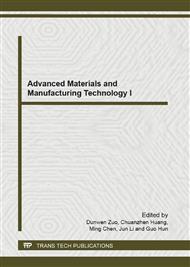p.3
p.7
p.11
p.15
p.20
p.24
p.28
p.32
Constitutive Relation Study for Vibration Isolation Rubber of Geometric Nonlinearity and Material Nonlinearity Based on Experimental Data Support
Abstract:
Static and quasi-static isothermal experiments were carried out on vibration isolation rubber sample pieces whose main raw material were nitrile rubber, Enhanced nitrile rubber and reclaimed rubber, then analysis and comparison on the acquired experimental data were carried out in detail. The causes of these phenomena were analyzed from macromolecules structure system entropy change. Mathematical model of the third time static loading of the above vibration isolation rubber sample pieces was established based on polynomial constitutive theory, considering softening effect and utilizing nonlinear data fitting technique. Mechanical performance parameters of the vibration isolation rubber material were studied in quasi-static cyclic loading condition, and vibration isolation performance was compared and analyzed.
Info:
Periodical:
Pages:
15-19
Citation:
Online since:
January 2012
Authors:
Price:
Сopyright:
© 2012 Trans Tech Publications Ltd. All Rights Reserved
Share:
Citation:


